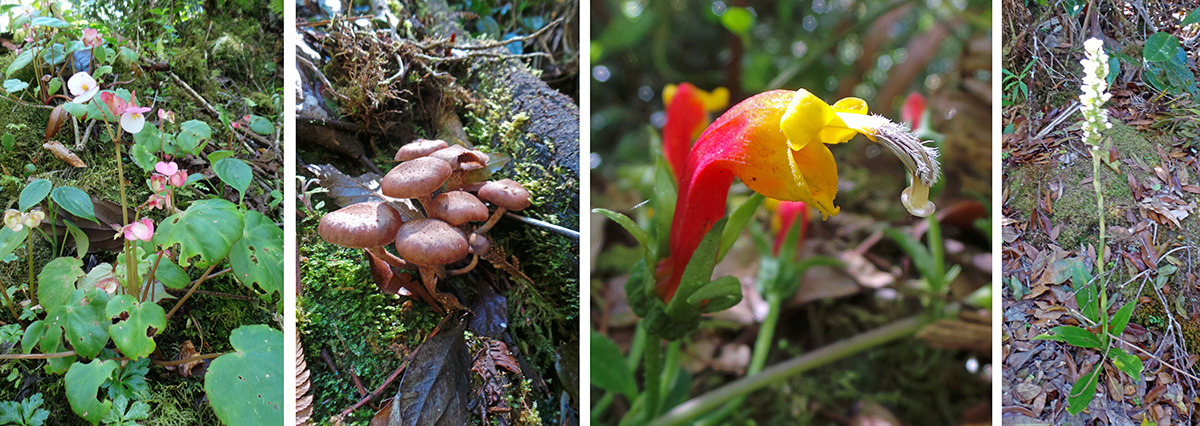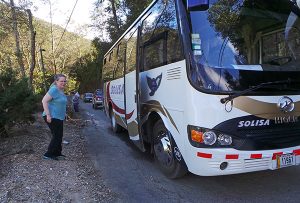This morning we headed further down the valley to Savegre Lodge where we loaded into two small 4WD vehicles for the tour into the forest on a steep, rutted dirt road full of rocks. Each vehicle had two bench seats in back along each edge, facing each other, that could accommodate up to 6 people. We bounced our way up the rugged road high into the primary forest, and after about a 10 minute ride got to a turnaround point where there were several trailheads.

Getting into the 4WD vehicles at Savegre Lodge (L), Mary, Barb and Marilyn inside one vehicle (LC), looking back while driving up (RC), and on the road into the forest (R).
We piled out into the pristine forest with tall trees towering overhead in the cool fresh air and walked first along the road and then along a narrow footpath that was a jumble of rocks and roots covered by fallen leaves (and having to crawl over a fallen tree at one point). We spent a lot of time with our necks craned upwards, looking high into the canopy for whatever birds we could see, always hoping one would be a quetzal. Most of them were too high up or moved too quickly to be able to take photos, but we saw a nice assortment including spangle-cheeked tanager, golden-bellied flycatcher, sooty-capped chlorospingus, yellow-thighed finch, black-cheeked warbler, collared redstart, and ruddy treerunner in the mixture of oak (Quercus costaricensis), trees in the Lauraceae, and many others creating a very high canopy. There were also a number of birds that we only heard and never spotted, including the black-faced solitaire with its distinctive melodic rusty door call, western wood peewee, mountain elaenia, and chestnut capped brush finch. A few bromeliads, orchids, and other epiphytes perched high on the limbs of some of the trees.

The trail covered with leaves (L), the primary forest (LC), looking up into the canopy (RC), and bromeliads high in a tree (R).
A lot of what we learned came from things that had fallen from the canopy – leaves and branches, whole bromeliads or orchid plants, flowers. Margherita picked up many of these to tell us about the ethnobotanical uses of some, which birds or animals fed on others, the ecology of still others.

Guide Margherita tells the group about a plant (L), fallen bromeliads (LC), Margherita talks about Clusia and Bocconia (RC) based on their fallen leaves (R).
The trail took us down to cross over a creek on a small metal bridge, then tromped along the slick rock and deep mud that served as the trail in many places with small pale pink-flowered begonias, tiny ferns, mosses, fungi and many other interesting plants covering the slope or rocks next to the trail.

The group on the trail (L), Deb photographs the creek (C), and hiking on the road (R).

Percy photographs a patch of sphagnum moss, Sphagnum magellanicum (L), closeup of the moss (LC), maidenhair fern (RC), and a weird parasitic plant, Helosis mexicana (R).

Small begonia (L), mushrooms (LC), flower of Centropogon sp. (RC), and a terrestrial orchid (R).
Eventually we headed up the trail to rejoin the road where we spotted many of the Bomarea vines clambering through the other vegetation, with their clusters of bright red tubular flowers conspicuous against the green. We spotted a couple of emerald toucanets, saw wild avocado trees covered in young fruit – aguacatillo – that is the main food of the resplendent quetzal and is also eaten by many trogons. Soon it was time to head down the mountain, so called to have the vehicles return to take us the rest of the way down.

Hairpin turn in the road (L), Bomarea flowers (LC), emerald toucanet (C), wild avocado tree (RC) and its fruits (R).

Suzanne looks in dismay as fluid runs from under the bus that is now blocking traffic.
After lunch we headed out for Parque Nacional Los Quetzales, Costa Rica’s newest national park (dedicated July 2005). Of course it is home to its namesake, the resplendent quetzal, and it was this beautiful iridescent green, red and turquoise bird that we were hoping to spot on this excursion. We’d barely gone a kilometer when the bus make a horrible shrieking noise and stopped – a belt was broken, so we weren’t going anywhere. Slightly disappointed, we walked along the road where quetzals had been seen recently, then returned to Trogon Lodge to relax for a bit and hope that maybe we’d spot the birds there. Some of us sat out on the back porch of the bar hoping that one of the birds would visit the small wild avocado tree adjacent to the porch, but soon moved inside as the wind picked up. A few people braved the chill to watch another tall wild avocado tree a little further away and were rewarded with a good sighting (but no photos) of the female, and a brief glimpse of the male. The female flew off and returned a couple of times to eat a few of the tiny green fruits, then dove off the tall tree in a flash of red and turquoise to disappear into the foliage. We waited a little longer, hoping the male would come in for a snack, but finally gave up as the light was beginning to fade.
